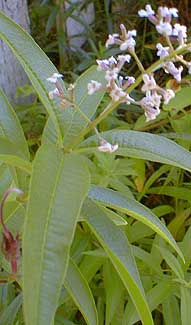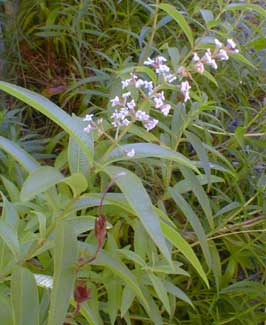
Lemon Verbena;
aka, Lemon Beebrush;
aka, Herb Louisa;
aka, Limonetto
"Nothing is more completely the child of art than a garden."
-Sir Walter Scott
(1771‚1832)
(1771‚1832)
Aloysia triphylla (formerly Lippia citriodora) has been long known to European gardeners as "Herb Louisa." The genus name Aloysia is a latinized form of Louisa, as it was named for Princess Louisa of Parma, wife of King Carlos IV of Spain. It was introduced to European gardening by Spanish explorers who in the 17th Century brought specimens back from Argentina & Chile.
 North American gardeners know it as Lemon Verbena. Many of its common names such as Limonetto or in France Verveine Citronelle allude to the wonderful lemony odor of the leaves. The scent is extremely pleasing & redolent even without having to bruise the leaves, & so sweet a scent that it is more reminiscent of a lemon-lime sucker than a sour lemon.
North American gardeners know it as Lemon Verbena. Many of its common names such as Limonetto or in France Verveine Citronelle allude to the wonderful lemony odor of the leaves. The scent is extremely pleasing & redolent even without having to bruise the leaves, & so sweet a scent that it is more reminiscent of a lemon-lime sucker than a sour lemon.A grower promotes it as "the queen of the lemony herbs!" & I'm inclined to call that an understatement. There are many citrusy-smelling shrubs & herbs for gardens, but this one out-does them all for pleasantness of the odor & for not needing to be wacked or bruised for the odor to be noticeable.
It's mainly grown for the shiny green leaves & their fabulous scent. As an ornamental it might otherwise be dismissed for too easily becoming lanky & wild-behaving, & the flowers are minor.
It produces the smallest white to pale lavender flowers in terminal panicles that can appear throughout the whole summer, but for us mainly in July. The blooms aren't bad but are such thin panicles tipped with such miniscule florets that they can go completely unnoticed. The flowers as well as the leaves , however, are used to make tea, or as a flavoring in vodka or other alcoholic beverages.
The leaves are useful for many things, & where grown commercially, oil extracts are provided for use in cosmetics & toiletries. Culinary uses are many, especially for deserts. An easy way to use the leaves is to steep them in milk, the milk then used as an ingredient for puddings, cake or cookie icings, or homemade icecream -- for anything calling for milk that would be pleasant with a lemony addition. The tenderest leaves can be used chopped up in salad dressings or in fruit salads, or left whole as a garnish for chilled drinks.
So many garden herbs make good teas, but many have such a sameness that it's hard to make oneself bother to use everything from the garden that is potentially appropriate, as ten different teas with more or less the same flavor can be monotonous. Not so for Lemon Verbena, which makes superior tea alone or mixed with other herbs or added to store-bought pecoes. As the most tea-worthy of garden herbs, it can be used to improve the comparatively mediocrity of such teas as catmint or giant purple hyssop.
The leaves can be dried for potpourri mixes of garden herbs. Leaves are strongest in scent & flavor while the shrub is in bloom, but can be harvested at any time. The tender tips of all the branches should be pruned back & the leaves saved throughout summer & autumn. The fact that the leaves are so useful does make it easier to remember to keep it trimmed. When thus maintained it will have an airy beauty rather than a horrid legginess.
It does have a few warnings about over-imbibing, as Lemon Verbena tea can be relaxing to the point of making it a bad idea to drive or operate machinery after drinking a great deal of it. It is alleged to lower blood pressure, slow heartbeat, & ease cramps or indigestion, though excessive use can have the opposite effect of stomach irritation.
It is suitable for our USDA Zone 8, & often adapts to Zone 7 with careful winter mulching or a sheltered location. But it only becomes a big shrub in warmer climates than here on Puget Sound. It is capable of growing ten to fifteen feet high & wide in tropical or subtropical climates, but in our temperate climate behaves more like a smallish die-back perennial instead of a large shrub.
In cool climates it requires full sun. In warmer climates it likes a tiny bit of shade. In colder zones it will have to be kept in containers to be brought into a shelter for winter, & kept nearly dry until its time to go back outside to releaf in spring. It is not drought-hardy while in leaf, & should not be allowed to dry out too often, but in rainy winters it is at some risk of root damage.
Though it can do well enough in the humusy fertile well-draining soils natural to our area, it would actually prefer a poorer sandy slightly alkaline soil, despite that in poorer soil it might want a monthly jolt of liquid fertilizer in order to provide continuously harvestable lemony foliage. With our naturally acidic soils, it is a good idea to feed the root of lemon verbena a stick or two of chalk to start off each spring.
It is sometimes described as semi-deciduous for the Pacific Northwest, but we've found it to be not only fully deciduous or even more on the order of die-back herbaceous perennial. It can sometimes hold its leaves through much of winter, but eventually all the leaves do fall, so the last leaves of autumn might as well be entirely harvested before they begin to look crappy.
The remaining twigs are spindly, of no particular ornamental value in & of themselves. It does not re-leaf until rather late in Spring. New growth in April might occur, depending on specific conditions, but in our garden it releafs at the tail-end of May. The first year we had it, I thought it died it was so slow to show that it was still alive. In our temperate zone, come spring, winter-killed branches just have to be cut out of it entirely before new growth begins.
Scratching the bark with a fingernail to check for greenness will reveal which branches are still alive. Even these should be pruned to much shorter lengths, if that wasn't already done when harvesting the last of the leaves before it went dormant. Or without regard for which twigs might releaf, the whole shrub can just be hard-pruned nearly to the ground, & it will reappear fresh & new starting in May.
In warmer climates it becomes a large woodier shrub with different care needs, but in Northwest gardens it is rarely larger than a lanky three by three feet, perhaps five feet when the root is extensive after a few years or if never harvested for its useful leaves. If a temperate gardener wanted it to be a larger shrub, it would have to be done as in cold climates, in containers to be brought into shelter during winter dormancy.
I find it practical & pleasant to have it as a herbaceous perennial, though. The resulting restricted size means it can be planted right by the path or, as we have it, at the gate-post nearest the back door, so that its aroma can be experienced daily. If it does per chance get large enough to intrude on a path, that's merely the excuse or reminder to prune it, & not coincidentally harvest it for the great culinary value of the leaves.